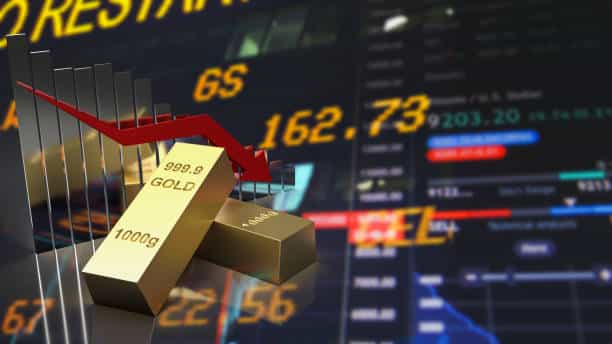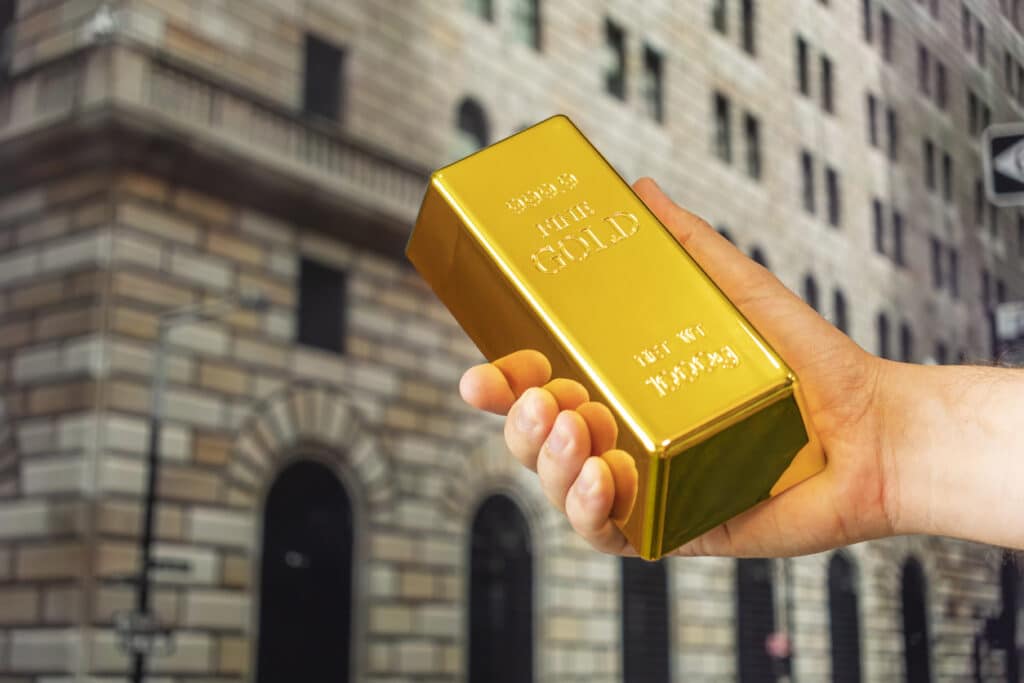
The word “precious” evokes thoughts of rarity and high value, describing things people yearn to possess. When the word “precious” is combined with “metals”, people envisage bars, ingots, coins, and medals, which are portable and, therefore, a good store of wealth. Moreover, the price trends of precious metals over decades, even centuries, reveal a significant appreciation in value that is representative of their utility.
Historically, the world’s monetary systems from 1870 to 1914 relied 100% on gold as a guarantee to reassure citizens that they could trust the value of their countries’ fiat currencies. Moreover, an ounce of fine gold (99.999% pure) on 15th August 1971 (the date that the Bretton Woods gold exchange began to be dissolved) was $43.15, growing to around $1,940.60 by January 2023. This figure represents an annual compound growth rate of 7.6% over a fifty-two-year stretch.
The precious metal (PM) category includes gold, silver, and platinum, which are the most popular investment ores), along with other exotic options such as iridium, osmium, palladium, rhodium, and ruthenium. This article digs deeper into the unique characteristics of precious metals and identifies what sets them apart from Base Metals and other commodities. It also examines how the differences between the metals impact their trading on futures and other markets.
Background
When people ask, “What are precious metals?” – it is a question to which there is no definitive answer. As intimated above, governments use gold and silver via mints to create money, which has a different value to the metal from which it is made. In addition, private mints also manufacture bars, ingots, and medals made from precious metals, although they do not produce official coins. Moreover, many private mints rely on their notoriety and reputation for survival. This reputation is established and supported by the Good Delivery List (issued by the London Bullion Market Association) – a recognised authority in the international precious metals marketplace.
Diversification is the Name of the Game
In our volatile economic environment, most savvy investors agree that PMs should account for at least 10% of an investment portfolio alongside stocks, bonds, cash, and real estate. In addition, financial advisors universally applaud PMs as the best hedges against inflation and as a counter-cyclical asset class protected against downtrends in traditional securities like the ones described above. Finally, PMs are used extensively in other sectors unrelated to currency, such as jewellery, manufacturing, and technology.
Four factors to consider when considering PMs are:
- How to invest in these metals?
- Where to store them?
- To whom can they be sold?
- Are there formal “stock exchange” avenues for acquiring them?
In summary:
- The PM spot price should not be relied on when (SP is defined as the price for immediate delivery) when investors seek to own the asset physically.
- When buying from dealers, the production cost of converting the metal into coins, bars, etc., figures into the equation, as do transport, storage, insurance overheads, and dealer profits. In a nutshell, additional premiums are included in the dealer’s price.
- Thus, there is a spread – the difference between the SP and what you end up paying for it. This disparity can be significant, which makes shopping around for the best prices for PMs a worthwhile pursuit.
- When reselling PMs, similar add-ons are factored into the equation. Therefore, dealers will again try to buy low to safeguard their profits.
- The investment size also counts, and larger quantities of PMs can generally be purchased at a discounted rate.
- Ironically, selling in smaller quantities is more manageable than, for example, one-pound bars.
Another factor that investors must consider when investing in PMs is storage.
- Keeping PMs in the home – even in wall safes – isn’t a great idea because of the risk of theft.
- Banks are reluctant to hold PMs in safety deposit boxes (although available) and notably will not insure such holdings.
The ownership of physical PMs isn’t a straightforward proposition. However, there are other compelling alternatives.
For example, most universally recognised stock exchanges offer regulated PM mutual funds or exchange-traded funds (ETFs). The difference between these funds and owning the metal outright is that the fund owns the PMs rather than the investor. Therefore, the fund manager is responsible for storing them and making crucial buying or selling decisions on behalf of investors. In other words, by investing in an ETF, you trust a professional to deliver long-term appreciation on any investment. Moreover, there are considerable benefits to opting for the ETF investment route rather than private ownership.
- Oversight provided by the SEC, in the US for example, assures investors that the ETF values correspond with those of precisely monitored physical PMs held in commercial vaults.
- The managers of ETFs have significantly more experience in trading PMs than retail investors and should, in theory, deliver better returns.
- The potential profits from ETFs should more than warrant the fund management fees. Therefore, it is reasonable to expect that the transactional and custodian costs will be at commercially acceptable levels.
Future Contracts
Another viable channel for dealing with PMs is through futures contracts, where investors speculate on the future price of an asset. For this type of trade, investors can perform a buy trade when they think the asset’s cost will rise. Alternatively, when an asset is likely to fall in price, investors can perform a sell, also known as “shorting” the asset, on the assumption it will go down in price.
The following steps show how a futures contract function:
- An investor buys 1000 ounces of gold at $1,940 per ounce on 1stFebruary and agrees to pay the seller on 28th
- Before the delivery date, the price rises to $1,950.
- The investor sells the asset at the current price of $1,950 and earns 1000 x $10 or $10,000 before deducting broker fees.
- In short, the investor never handled the gold, stored it, or even saw it. Yet, they made a profit of $10,000 on the trade.
However, there are other important factors to consider when investing in futures contracts.
- Very few PM contracts run the full term. In other words, traders in PMs generally reverse the deal before the closing date of the contract.
- In the example above, committing to 1000 ounces of gold requires a capital of $1,940,000, which may be too much for many investors. This is where broker leveraging kicks in.
What does broker leveraging mean when investing in PMs?
Many brokers lend investors the capital to perform trades for PMs. This lending process is known as “leveraging”, which can mean higher profits if an asset rises in price, but it can also result in higher losses should the asset fall in value.
How leveraging works
- An investor with $40,000 may receive leverage of x50 (i.e., $40,000 x 50 = $2 million). This would provide the investor with sufficient funds to purchase 1000 ounces of gold at the cost of $1,940,000, as per the example above,
- Leverage can be advantageous to traders, specifically when the asset price rises and the trader receives profits for capital they never possessed in the first place.
- However, being on the losing end of a leveraged trade can be devasting for an investor. Small fluctuations in price result in much bigger movements of profit and loss because of the additional funds provided by the broker. Therefore, once an investor’s initial non-leveraged stake is depleted, fund managers are reluctant to allow these losses to become too high and may sell the asset, resulting in a loss for the investor.
- Trading with leverage can result in higher profits, but it is not without risk. For example, when an asset falls, brokers often issue “margin calls”, requesting additional funds to cover the cost of the investment risk.
Think of it this way: Even without a margin call, a $10,000 win or loss in one month on a $40,000 stake is an annualised profit or loss of 300%. However, compared to an outlay of $1,940,000, this number equates to only 6% annually.
So, with this understanding, let’s return to investing directly in PMs:
- Suppose a trade is profitable, and the investor wants to accumulate the profits in physical gold (i.e., $10,000’s worth) after paying the broker fees.
- The investor may see through the term of the contract unleveraged. Therefore, as a buyer, they may decide to take delivery of 1000 ounces of gold or to deliver it if they are selling.
- Brokers are prepared for this type of scenario and are willing to store assets at a cost to the investor.
- Many investors choose to perform the above options. However, it is a convoluted path and investing in ETFs is seen as less risky and more straightforward.
Another point to consider is that not all metals are traded similarly. Successful PM trades for common metals like gold and silver often depend on the asset’s liquidity, allowing investors to quickly enter and depart a contract. Contrastingly, the more uncommon and lesser-traded metals may not have the liquidity to move at the speed investors require.
- It is recommendable to trade in precious metals with high liquidity.
- When trading PM contracts with leveraging, it is advisable to insert stop losses. Thus, if your predictions go awry, the damage can be contained, and the chance of margin calls is reduced.
Related Articles
Conclusion
This article summarises precious metals and explains how to invest in them. Owning physical PMs as diversification assets is not conducive to quickly executed trades. Instead, a lengthy hold position that may take several years is a sensible option. Also, transporting, storing, insuring, and reselling physical PMs is logistically complex, especially for sole traders.
On the other hand, the options market – where taking possession of the metal isn’t necessary – is ideal for rapid moves. There are two typical outcomes to trading PMs on options markets:
- Sizable returns on profitable trades if investors can shoulder the risks associated with making them.
- An increased loss of capital on negative leveraged trades.
PM contracts on options platforms are ideal for active, seasoned metals traders. Conversely, the PM ETF category, with flexible scales of economy and regulatory oversight, is the least stressful investment method for investors seeking long-term growth and those not averse to risking capital.
Forextraders' Broker of the Month
BlackBull Markets is a reliable and well-respected trading platform that provides its customers with high-quality access to a wide range of asset groups. The broker is headquartered in New Zealand which explains why it has flown under the radar for a few years but it is a great broker that is now building a global following. The BlackBull Markets site is intuitive and easy to use, making it an ideal choice for beginners.

